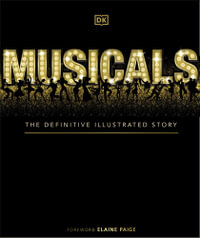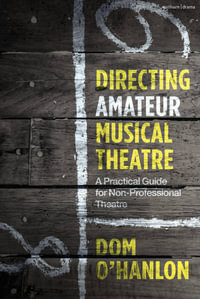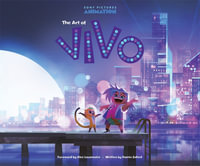
At a Glance
216 Pages
24.41 x 16.99 x 1.27
Hardcover
RRP $160.00
$118.80
26%OFF
or 4 interest-free payments of $29.70 with
orAims to ship in 25 to 30 business days
What does a musical theatre choreographer actually do? They just 'make up the steps', right?
This book firstly debunks the misunderstandings around what musical theatre choreographers actually do, demonstrating their need to have an in-depth understanding of storytelling, music theory, performance practices and plot structure in order to create movement that enhances and enlivens the musical.
Secondly, it equips the musical theatre choreographer with all the tools needed to create nuanced, informed and inspired movement for productions, through structured activities that build specific skills (such as 'notating the script' and 'scoring the score').
Traditionally, this training has been something of a series of secrets, passed from mentor to apprentice. The author demystifies the process to make the previously undisclosed "tricks of the trade" accessible to all choreographers, everywhere.
Covering the entire process of choreographing a musical from the first script reading to the final curtain call, this book makes case for the absolute integrity of the choreographer to any musical theatre production and sets out the theoretical principles of choreography alongside the practical application during every step of the production process.
a. Tradition: An Art Form Passed Down
b. Within These Pages: How to Utilize the Text
PART 1: THE ART
1. CHAPTER 1: Where to Start
1.1. The Musical Theatre Choreographer
1.2. The Evolution of Dance on Broadway
1.2.1. The African, Caribbean, and East Indian Influence
1.2.2. The European Influence
1.2.3. The Director/Choreographer and the Concept Musical
1.2.4. Contemporary Musical Theatre Choreographers
1.3. Choreographing in a New Era of Musical Theatre
2. CHAPTER 2: Research
2.1. The World of the Piece
2.1.1. Historical Context
2.1.2. Culture
2.1.3. Visual Landscape
2.1.4. Words, Words, Words
2.2. The Life of the Piece
2.2.1. Listening
2.2.2. Style
2.2.3. Movement Vocabulary
2.3. The People of the Piece
2.3.1. The Role of the Ensemble
2.4. The History of the Piece
2.4.1. Source Material
2.4.2. The Creators
2.4.3. Previous Productions
2.5. Revivals: Making Something Old New Again
2.5.1. Copyright and Licensing
2.6. ACTIVITY: Visual Lookbook
2.7. ACTIVITY: Movement Reel
3. CHAPTER 3: Storytelling Through Movement
3.1. The Musical Structure
3.2. Roles of Choreography in the Musical
3.3. Script Analysis: Creating a Movement Arc
3.4. Movement Events
3.5. ACTIVITY: Movement Roadmap
4. CHAPTER 4: Interpreting the Score
4.1. The Basics
4.1.1. Meter and Rhythm
4.1.2. Time Signatures
4.1.3. Staves and Clefs
4.1.4. Key Signatures
4.1.5. Expressions, Articulations, and Dynamic Markings
4.1.6. Other Important Markings
4.1.7. Musical Passages and Transitions
4.2. Music Through a Dance Lens
4.2.1. What you Hear Versus What You See
4.2.2. Musical Changes, Counting, and Cutting
4.2.3. Physical Interpretation
4.3. ACTIVITY: Discovering the Cut
4.4. ACTIVITY: Drawing the Musical Phrases
4.5. ACTIVITY: Scoring the Score
5. CHAPTER 5: Musical Staging
5.1. Earning the Song
5.2. Music as Action
5.3. Stage Moods
5.4. Partners
5.5. Movement While Singing
5.5.1. Motion
5.5.2. Crosses: When and How
5.5.3. Gestures
5.5.4. Stillness
5.5.5. Stylization
5.5.6. Physical Comedy
5.6. The Mini-Build
5.7. Sample Staging Outline: Solo
5.8. Sample Staging Outline: Duet
5.9. ACTIVITY: Notating in the Script
6. CHAPTER 6: Production Numbers
6.1. Beat Breakdown
6.2. How to Create a Build
6.2.1. Types of Builds
6.2.2. Groupings
6.2.3. Eliciting Applause
6.2.4. Buttons
6.3. Nuts and Bolts
6.3.1. Focus
6.3.2. Level and Direction
6.3.3. Repetition and Visual Variation
6.3.4. Individual Versus Unison
6.3.5. Balance: Symmetrical Versus Asymmetrical
6.4. Formations
6.4.1. Lines
6.4.2. Curves
6.4.3. Other Formations
6.4.4. Multiple Formations
6.5. Movement Patterns
6.6. Diagrams
6.7. ACTIVITY: Analyzing the Build
6.8. ACTIVITY: Building the Build
7. CHAPTER 7: Creating Steps
7.1. Process
7.1.1. The Five Parts of Dance
7.1.2. Intention
7.1.3. Style
7.1.4. Economy
7.2. Creation
7.2.1. Research
7.2.2. Abstraction
7.2.3. Physical Metaphor
7.2.4. Dance Journaling
7.2.5. Movement Prompts
7.2.6. Efforts
7.2.7. Objectives and Drives
7.3. Fundamentals
7.3.1. Initiation and Framing
7.3.2. Shapes and Transitions
7.3.3. Choreographing the Eyes
7.3.4. Rhythm, Speed, and Syncopation
7.3.5. Contrast, Isolation, and Accent
7.3.6. Pauses, Freezes, and Sounds
7.3.7. Dancers as Objects
7.3.8. Crowd Movements
7.4. Utilizing the Design
7.5. Notation
7.6. ACTIVITY: Steps Notation
8. CHAPTER 8: Adapting to Various Spaces
8.1. Types of Spaces
8.2. Site Specific Theatre
8.3. Benefits and Challenges
8.4. Tricks of the Trade
8.5. Formations
8.6. Movement Patterns
8.7. Creating Focus
8.8. Musical Staging
8.9. Storytelling
8.10. ACTIVITY: From Proscenium to the Round
PART 2: THE PRACTICE
9. CHAPTER 9: Assembling Your Team
9.1. Members of the Choreographic Team
9.1.1. Dance Captain
9.1.2. Assistant Choreographer
9.1.3. Associate Choreographer
9.2. Pre-Production
9.3. Auditions
9.3.1. Audition Breakdown
9.3.2. Dance Calls
9.3.3. Audition Combination
9.3.4. In the Room
9.3.5. Making the Cut
9.4. ACTIVITY: The Dance Audition Combination
10. CHAPTER 10: Collaboration
10.1. Design and Production Meetings
10.1.1. Creative Discussions
10.1.2. Design Meetings
10.1.3. Break Out Meetings
10.1.4. Production Meetings
10.2. Collaborating with the Director and Music Director
10.2.1. The Director
10.2.2. The Music Director
10.2.3. The Dance Arranger
10.3. Collaborating with the Design Team
10.3.1. The Set Designer
10.3.2. The Costume Designer
10.3.3. The Lighting Designer
10.3.4. The Sound Designer
10.4. The Stage Manager
10.5. The Director/Choreographer
10.6. ACTIVITY: Question Lists
11. CHAPTER 11: Rehearsals
11.1. Types of Rehearsals
11.1.1. Staging Rehearsals
11.1.2. Cleaning Rehearsals
11.1.3. Run-Throughs
11.1.4. Spacing Onstage
11.1.5. Sitzprobe and Wandelprobe
11.1.6. Technical Rehearsals
11.1.7. Previews
11.2. Running Rehearsals: How to Lead
11.2.1. Working with Performers
11.2.2. Giving Notes
11.3. ACTIVITY: Rehearsal Timeline
12. CHAPTER 12: All the Other Things
12.1. Transitions
12.2. Contact and Intimacy
12.3. Improvisation
12.4. Child Performers
12.5. Special Skills
12.6. Curtain Call
12.7. Photo Call
12.8. Rehearsing Understudies and Swings
12.9. Accessibility
12.10. Activity: Tracking Transitions
13. CHAPTER 13: Nice Work If You Can Get It
13.1. Finding Work
13.2. Creating Your Own Work
13.3. Displaying Your Work
13.4. ACTIVITY: Choreography Reel
APPENDIX: Suggested Reading
ISBN: 9781350193345
ISBN-10: 1350193348
Published: 20th October 2022
Format: Hardcover
Language: English
Number of Pages: 216
Audience: College, Tertiary and University
Publisher: BLOOMSBURY 3PL
Country of Publication: GB
Dimensions (cm): 24.41 x 16.99 x 1.27
Weight (kg): 0.54
Shipping
| Standard Shipping | Express Shipping | |
|---|---|---|
| Metro postcodes: | $9.99 | $14.95 |
| Regional postcodes: | $9.99 | $14.95 |
| Rural postcodes: | $9.99 | $14.95 |
How to return your order
At Booktopia, we offer hassle-free returns in accordance with our returns policy. If you wish to return an item, please get in touch with Booktopia Customer Care.
Additional postage charges may be applicable.
Defective items
If there is a problem with any of the items received for your order then the Booktopia Customer Care team is ready to assist you.
For more info please visit our Help Centre.























